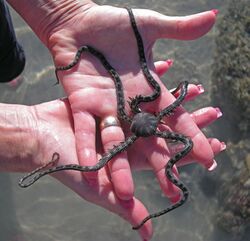Biology:Ophiocomella alexandri
| Ophiocomella alexandri | |
|---|---|

| |
| Opiocomella alexandri in the Gulf of California | |
| Scientific classification | |
| Domain: | Eukaryota |
| Kingdom: | Animalia |
| Phylum: | Echinodermata |
| Class: | Ophiuroidea |
| Order: | Ophiacanthida |
| Family: | Ophiocomidae |
| Genus: | Ophiocomella |
| Species: | O. alexandri
|
| Binomial name | |
| Ophiocomella alexandri (Lyman, 1860)
| |
| Synonyms | |
| |
Ophiocomella alexandri, known as Alexander's spiny brittle star or banded brittle star, is a species of marine brittle star. It was first described to science by Theodore Lyman in 1860.[1] Lyman states in his description that the animal is named for his friend, Alexander E. R. Agassiz, the son of Lyman's mentor, Louis Agassiz.
Description
This animal is pentaradially symmetric with five arms attached to a central disk. It is dark brown in color, with lighter bands on the upper side of the arms. The lighter parts are gray with hints of green or yellow tones. The colors change on a daily cycle, which, like the banding, may be a form of camouflage to hide the brittle star from predatory fish. Males and females are identical in appearance.[2]
The central disk is rounded with small bumps on its upper side. The disk can be up to 25.2 millimetres (0.99 in) across. It contains the mouth, digestive system, and gonads.[2]
The arms are very flexible, but when straight give the brittle star a diameter of up to 450 millimetres (18 in). As its common name suggests, the arms are quite spiny, with five to seven long spines on each lateral plate.[2][3]
Distribution
This brittle star lives from the intertidal zone to a depth of 70 meters (230 feet). It is benthic, living on the sea bed, favoring rocky bottoms and coral reefs.[4][3] The species lives in the eastern Pacific Ocean from southern California to Colombia, including the Gulf of California.[2] It is found in the Galapagos Islands.[5]
Life history
Alexander's brittle stars reproduce by broadcast spawning. It is gonochoric, having individuals that are either male or female, with approximately equal numbers of each sex. Males and females release sperm and eggs into the sea where they meet for fertilization.[6] These zygotes develop into free-swimming pluteus larva.[7]
This species feeds on detritus.[8] There is evidence that these brittle stars catch and eat small fish in aquariums.[9]
References
- ↑ Lyman, Theodore (1860). "Descriptions of new Ophiuridae, belonging to the Smithsonian Institution and to the Museum of Comparative Zoology at Cambridge". Proceedings of the Boston Society of Natural History 7: 252–262. https://www.biodiversitylibrary.org/page/9249753#page/260/mode/1up.
- ↑ 2.0 2.1 2.2 2.3 Granja–Fernández, Rebeca; Herrero-Pérezrul, María D.; López-Pérez, Ramón A.; Hernández, Luis; Rodríguez-Zaragoza, Fabián A.; Jones, Robert Wallace; Pineda-López, Rubén (2014-05-07). "Ophiuroidea (Echinodermata) from coral reefs in the Mexican Pacific". ZooKeys (406): 101–145. doi:10.3897/zookeys.406.6306. ISSN 1313-2989. PMID 24843284.
- ↑ 3.0 3.1 Kerstitch, Alex N.; Bertsch, Hans (2007). Sea of Cortez marine invertebrates : a guide for the Pacific coast, México to Perú (2nd ed.). Monterey, Calif.: Sea Challengers. pp. 112. ISBN 978-0-930118-41-9. OCLC 76184242.
- ↑ "Ophiocoma alexandri". https://www.sealifebase.ca/summary/Ophiocoma-alexandri.html.
- ↑ "Galapagos Species Checklist" (in en-gb). https://www.darwinfoundation.org/en/datazone/checklist.
- ↑ Benítez-Villalobos, Francisco; Aguilar-Duarte, Catalina; Avila-Poveda, Omar Hernando (November 6, 2012). "Reproductive biology of Ophiocoma aethiops and O. alexandri (Echinodermata: Ophiuroidea) from Estacahuite Bay, Oaxaca, Mexico". Aquatic Biology 17 (2): 119–128. doi:10.3354/ab00467. https://www.int-res.com/articles/ab2012/17/b017p119.pdf.
- ↑ Whitehill, Elizabeth A. G.; Moran, Amy L. (2012). "Comparative larval energetics of an ophiuroid and an echinoid echinoderm". Invertebrate Biology 131 (4): 345–354. doi:10.1111/j.1744-7410.2012.00277.x. ISSN 1077-8306.
- ↑ "BrittleStars". http://www.wetwebmedia.com/brittlestars.htm.
- ↑ "Brittle Star Gone Bad? Missing clowns - Reef Central Online Community". http://reefcentral.com/forums/showthread.php?t=1909414.
Wikidata ☰ Q61470905 entry


